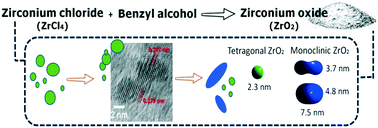当前位置:
X-MOL 学术
›
CrystEngComm
›
论文详情
Our official English website, www.x-mol.net, welcomes your
feedback! (Note: you will need to create a separate account there.)
Particle anisotropy and crystalline phase transition in one-pot synthesis of nano-zirconia: a causal relationship†
CrystEngComm ( IF 2.6 ) Pub Date : 2017-12-15 00:00:00 , DOI: 10.1039/c7ce01949a Francesca Tana 1, 2, 3, 4 , Andrea Serafini 1, 2, 3, 4 , Luca Lutterotti 4, 5, 6, 7 , Alberto Cigada 1, 2, 3, 4 , Fabio Variola 8, 9, 10, 11 , Federica Bondioli 4, 12, 13, 14 , Luigi De Nardo 1, 2, 3, 4
CrystEngComm ( IF 2.6 ) Pub Date : 2017-12-15 00:00:00 , DOI: 10.1039/c7ce01949a Francesca Tana 1, 2, 3, 4 , Andrea Serafini 1, 2, 3, 4 , Luca Lutterotti 4, 5, 6, 7 , Alberto Cigada 1, 2, 3, 4 , Fabio Variola 8, 9, 10, 11 , Federica Bondioli 4, 12, 13, 14 , Luigi De Nardo 1, 2, 3, 4
Affiliation

|
Crystalline phase evolution and morphological changes are strictly correlated phenomena during the growth of zirconia nanoparticles. In this work, the effects of synthetic variables, reaction time (up to 24 hours) and precursor concentration (0.16 and 0.5 M), of a one-step non-hydrolytic sol–gel route to zirconia are investigated. Zirconium tetrachloride (ZrCl4) is chosen as a zirconium oxide precursor to react in benzyl alcohol. At a low precursor concentration and a short reaction time, pseudo-spherical particles of size 2 nm with a narrow size distribution are observed by transmission electron microscopy (TEM). At this stage, mainly the tetragonal phase is detected. By increasing both the zirconium precursor concentration and reaction time, a broadening of size distribution is observed resulting from the growth of anisotropic particles. Concurrently, an increasing amount of the monoclinic is detected by X-ray diffraction and Raman spectroscopy. As a novelty, Rietveld investigations on electron diffraction ring patterns obtained by transmission electron microscopy are performed. This procedure allows the collection of comprehensive information about nanostructured particles in one-step analysis. The results derived from this analysis, together with the high resolution transmission electron microscopy (HR-TEM) data, consistently support the structural transition from pseudo-spherical tetragonal particles to rice-shaped monoclinic particles.
中文翻译:

一锅法合成纳米氧化锆中的颗粒各向异性和结晶相变:因果关系†
晶体相演变和形态变化是氧化锆纳米粒子生长过程中的严格相关现象。在这项工作中,研究了合成变量,反应时间(长达24小时)和前驱体浓度(0.16和0.5 M)对一步法非水解溶胶-凝胶法合成氧化锆的影响。四氯化锆(ZrCl 4选择)作为在苄醇中反应的氧化锆前体。在低前驱物浓度和短反应时间下,通过透射电子显微镜(TEM)观察到尺寸为2 nm的伪球形颗粒,尺寸分布较窄。在这一阶段,主要检测到四方相。通过增加锆前驱物的浓度和反应时间,观察到由于各向异性颗粒的生长而导致的尺寸分布变宽。同时,通过X射线衍射和拉曼光谱法检测到单斜晶的数量增加。作为新颖性,对通过透射电子显微镜获得的电子衍射环图案进行了Rietveld研究。此过程允许在一步分析中收集有关纳米结构颗粒的全面信息。
更新日期:2017-12-15
中文翻译:

一锅法合成纳米氧化锆中的颗粒各向异性和结晶相变:因果关系†
晶体相演变和形态变化是氧化锆纳米粒子生长过程中的严格相关现象。在这项工作中,研究了合成变量,反应时间(长达24小时)和前驱体浓度(0.16和0.5 M)对一步法非水解溶胶-凝胶法合成氧化锆的影响。四氯化锆(ZrCl 4选择)作为在苄醇中反应的氧化锆前体。在低前驱物浓度和短反应时间下,通过透射电子显微镜(TEM)观察到尺寸为2 nm的伪球形颗粒,尺寸分布较窄。在这一阶段,主要检测到四方相。通过增加锆前驱物的浓度和反应时间,观察到由于各向异性颗粒的生长而导致的尺寸分布变宽。同时,通过X射线衍射和拉曼光谱法检测到单斜晶的数量增加。作为新颖性,对通过透射电子显微镜获得的电子衍射环图案进行了Rietveld研究。此过程允许在一步分析中收集有关纳米结构颗粒的全面信息。











































 京公网安备 11010802027423号
京公网安备 11010802027423号